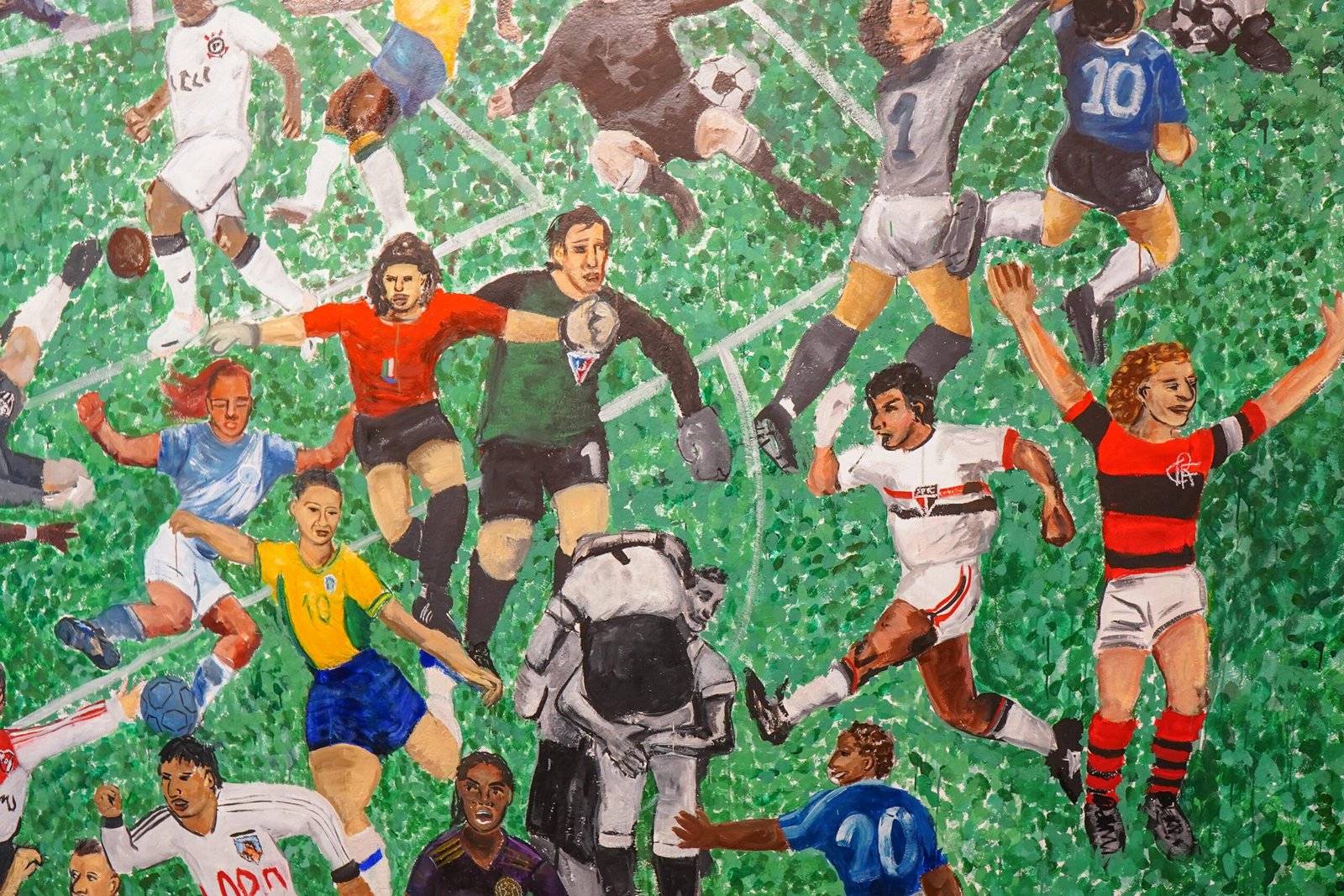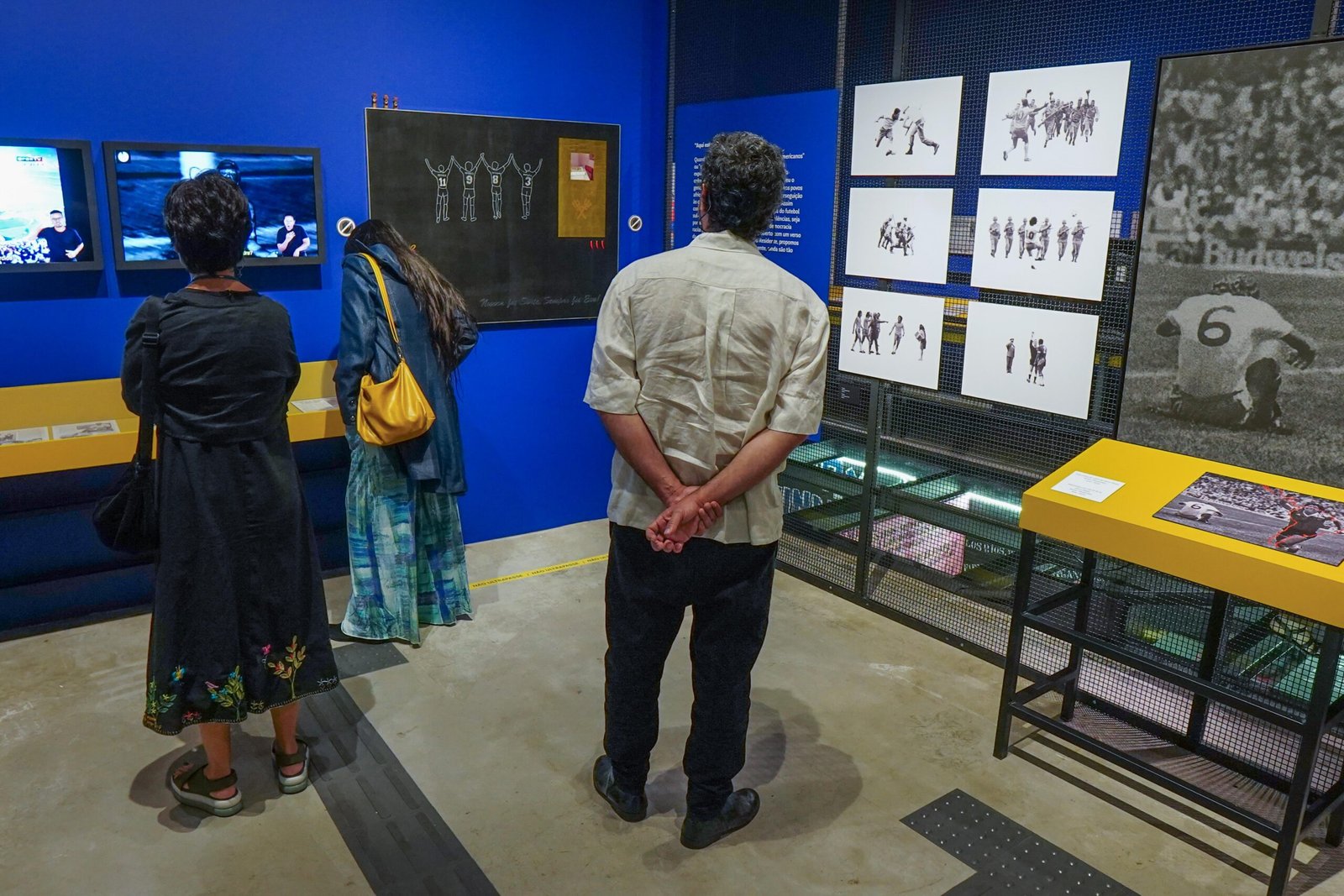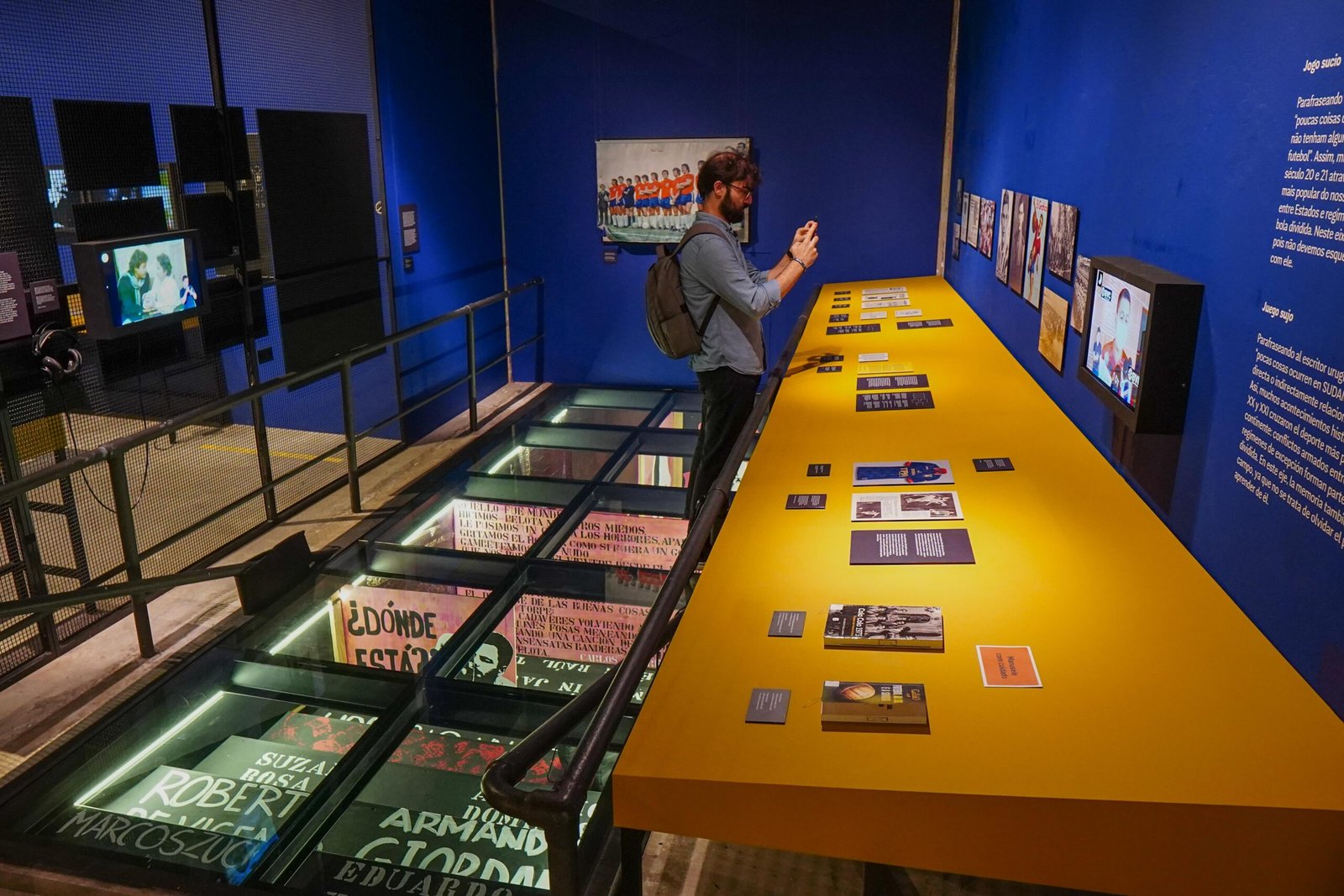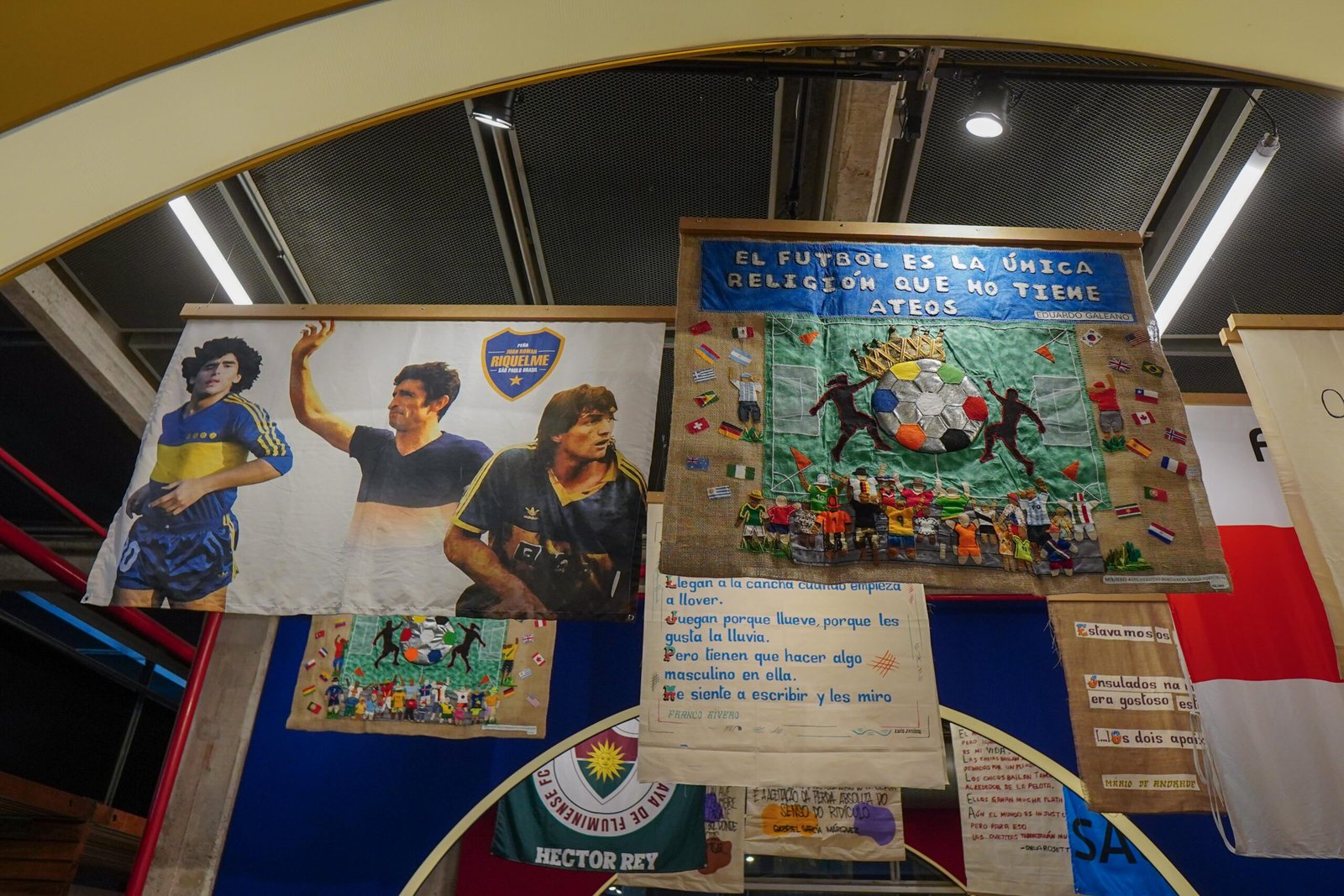TEMPORARY EXHIBIT
¡Cancha Brava! South American Football in Dispute
Museu do Futebol [Football Museum] explores the world of South American football, crossing Brazilian borders to share and discuss the history of the countries that make up the South American Football Confederation (CONMEBOL). The new temporary exhibition, ¡Cancha Brava! Futebol sudamericano en disputa [South American Football in Dispute], invites visitors to experience the achievements and confrontations on the field as well as the overwhelming passion that drives South Americans, and their conflicts and contradictions, highlighting soccer as one of the continent’s most striking cultural manifestations.
Date
From October 17, 2025, to April 5th, 2026
Opening Hours
Tuesday to Sunday
9 am to 6 pm (entry permitted until 5 pm)
Every first Tuesday of the month, until 9 pm (entry allowed until 8 pm)
Tickets
R$ 24,00 Full
R$ 12,00 Students
Free for children under 7
Free for all on Tuesdays
Collect directly from the ticket office or through Sympla.
See other free offers.
How to get there
Click here and access different transportation options
A historical, political and poetic journey
The exhibition, curated by Luiza Romão, Matias Pinto, and Gisele de Paula, offers a historical, political, and poetic journey through the subcontinent based on football. It explores audiovisual installations, soundscapes, interactive experiences, photographs, and artworks, many of which were produced exclusively for the exhibition. Sponsors of the exhibition include Mercado Livre, Arkema, Goodyear, Farmacêutica EMS, and Itaú, with additional support from Adidas, Grupo Globo, Pinheiro Neto, Zanchetta, and Sabesp—all through the Federal Culture Incentive Law, Lei Rouanet.
As the title suggests, the exhibition is bilingual, exploring the intersections between Portuguese and Spanish. Cancha is a word of Quechua origin that means both ‘popcorn’ and ‘field’. And Brava means both “angry” and “great”. Together, they describe the fans who support and follow their teams intensely and unconditionally, everywhere, through thick and thin. !Cancha Brava! is thus a synthesis of the history of our football, comprising a lot of passion, peculiarities and fifty-fifty balls.
“The word ‘cancha’ carries an ancestral and indigenous memory that predates football itself. And when we add ‘brava’ to it, we capture the intensity, vibrancy, and collective nature of the South American experience of the game, which is often confrontational. This title does not express a fixed essence, but rather a particular way of transforming football into part of our culture,” says curator Gisele de Paula.
Luiza Romão sheds light on the off-field aspects of South American soccer. For her, the sport ”reveals both what brings us together and what sets us apart,” and is characterized by both celebration and competition. Politics has also occupied this territory, with dictatorial regimes using stadiums for propaganda and as centers of repression. “The history of South American football is made up of tensions, but also of celebration, passion, music, poetry, and art,” she summarizes.

Party and resistance
¡Cancha Brava! Futebol sudamericano en disputa celebrates football as a collective invention, one of resistance and celebration. The exhibition discusses how the game is not only permeated by celebration and passion, but also by the various conflicts present in South America, such as colonialism, racial discrimination, inequality, authoritarianism, and violence. It invites the public to step onto the pitch along the memory, the affection, and the struggle of the people who resist through the medium of football.
The exhibition is divided into the following sections: “Stealing the Ball”, “A Century of Celebration and Rivalry,” “Interlude,” “Foul Play,” “We Are Here so You Remember,” and “A Never-Ending Carnival.”
Right at the beginning, visitors are greeted by an interactive sound installation. They can choose a “station” corresponding to one of the ten countries in the region from a giant radio dial. The selected country is illuminated on an interactive map while local music plays and a native of that country narrates general information on demographics, geography, and football—in Portuguese, but with a Castilian accent. The voices belong to announcers and ordinary people—born in various countries, but living in Brazil—who were involved in the production of the exhibition in some way.
In the central space of the exhibition is a grandstand that evokes the festive atmosphere of stadiums. It features chants from 25 South American fan clubs that parody well-known songs. The structure is equipped with a bass shaker mechanism that makes it vibrate in time with the sound.

Artworks
Among the original works produced for the exhibition is the mural “Un siglo de fiesta y rivalidad” [A Century of Celebration and Rivalry] by artists Marina Ceglie and Cleber TTC. The mural features a perspective view inside a soccer stadium with more than 180 characters depicting South American soccer personalities and stories. Visitors will be challenged to discover who the characters are.
Another new addition is Sabrina Savani’s site-specific work, “Escadaria de Memória” [Stairway of Memory], an intervention on the staircase that used to connect the old Pacaembu locker room to the field. Visitors can walk on a glass floor above the installation, which offers a poetic and political reflection on the recent history of South America, based on the memory of victims of military dictatorships.
Jaime Lauriano will present his work, “Nunca Foi Sorte” [It Was Never Luck], which uses acrylic, stickers, photographic prints, and wooden miniatures. Shirley Espejo’s collage of important but little-known Black South American soccer players will play with the audience’s memory.
Other artists presenting works include Mulambo, Roberta Estrela D’Alva, and Frente 3 de Fevereiro.

Language and literature
The exhibition also explores the relationship between South American literature and football, as well as its connection to popular art. Quotes from renowned authors like Uruguayan Eduardo Galeano, Colombian Gabriel García Márquez, and Brazilian Mário de Andrade are featured using various visual techniques, including Chilean arpilleras embroidery and Brazilian abridores de letras, a method employed for painting boats in Belém, Pará.
Portuguese and Spanish coexist in an interactive glossary where visitors can select a football-related word and discover its equivalents in both languages, as well as the variations between countries. Among the exhibition’s various accessibility features, this installation will include a Braille table displaying the available terms. Blind visitors will be able to activate the device using voice commands.
Regarding the visitor experience, Luiza Romão says, “We tried to create a journey that provides (historical, cultural, etc.) information while provoking immersive experiences for the public. To this end, the exhibition features documents, photographs, books, sound installations, interactive games, and fan paraphernalia.”
Matias Pinto hopes that visitors will recognize themselves in the diversity of South America. “Visitors will find a mix of information and emotion. We sought out the most interesting stories and characters from our continent, ranging from football stars and cultural icons to nearly anonymous figures. The mural designed by Marina Ceglie and Cleber TTC and the installation by Sabrina Savani are two pieces that will only be available during this exhibition.”

Gallery
Technical file
Curatorial Group
Luíza Romão, Matias Pinto and Gisele de Paula
Production Coordination
Leslie Arias
Production
Renato Magalhães and Vinicius Nunes
Expographic Design
Gisele de Paula Arquitetura & Cenografia
Administrative Assistant
Tamara Ramos
Expographic Assistants
Iolaos Coelho, Alexandra Souza and Anna Carolina Madureira
Visual Communication
Didiana Prata and Maria Meira – Prata Design
Guest Artists
Coletivo Mujeres Arpilleristas – Eduardo Galeano Flag, Coletivo Linhas Nove – Bandeira Blanca Varela e Roberto Fontanarrosa, Luís Junior – Franco Rivero and Mário de Andrade Flag, Marina Ceglie da Silva – Dalia Rosetti and Roberto Fontanarrosa Flab, Be.e.PH – Pedro Lemebel and Gabriel García Márquez Flag, Marina Ceglie da Silva and Cleber TTC – Um século de fiesta y rivalidade Mural, Mülambo – Diego and Perigo de gol Series, Sabrina Savani – Escadaria da memória, Shirley Espejo – Futebol é construir com a cancha uma comunidade, Frente 3 de Fevereiro – Bandeiras, Roberta Estrela d’Alva e Fernando Coster – Herói tombado, Jaime Lauriano – Nunca foi sorte #2
Set Design
Secall
Printing
Secall – Visual Communication
Pigma – Mural poster
Lighting design
Julio Katona
Lighting Installation
Felipe Bonfante, Gilson Alves da Silva and Daniel Rodrigues
Audiovisual Team
MMV Montagem Audiovisual
Multimedia Map of Musics
Mandelbrot – Development
Jukebox – Editing and Recording of Narrations
Patricia Dainese – Production Coordination and Thiago Chasseraux – Productor
Narrators – Map of Musics
Argentina: Nico Cabrera
Bolivia: Juan Montecinos
Brazil: Alessandro Jodar
Chile: Maghi Contreras
Colombia: Victoria Saavedra
Equador: Leslie Carolina Mendez Gruezo
Paraguay: Victória Figueiredo
Peru: Martha Galdos
Uruguay: Lea Bensason
Venezuela: Juan Guadelis
Multimedia Carnaval toda la vida
[ComponenteArte]
Thiago Henrique Strassalano, Adriano Moraes, Paulo Ueno, Ricardo Moreira and Keu Maria
Video Editing
Cristiano Fukuyama
Map of Friendship
Nico Cabrera (Observatório Social do Futebol/ UFRJ) – Content
Ciano Estúdio Criativo – Graphic design
Research
Leonardo Miranda and Marcel Tonini (CRFB)
Licensing
Marco Paraná and Dóris Régis (CRFB)
Illustration Termos do Interlúdio (Glossary)
Maíra Martines
Artwork Transport
Grupo Alke
Collection Insurance
Howden
Accesibility
Lara Souto and Edinho Santos – Consultant
Iguale – Scripts, audio descriptions, and signage
TB – Flooring, map, and signs Tactile
Casa do Braille – Tactile Arts
Art hadling
Ladun Produções e Montagem – Juliana Ladun, Avelino Regicida e Zicra Monique
Escadaria da Memória – Edivaldo de Sena, Claudia A. Savani Sena and Raissa Figueiredo Vieira
Text Editing
Fabiana Pino (Portuguese) and Rocío Torres (Spanish)
Translations
Agência Dica
AVCB Project
ARQ IN OFF


